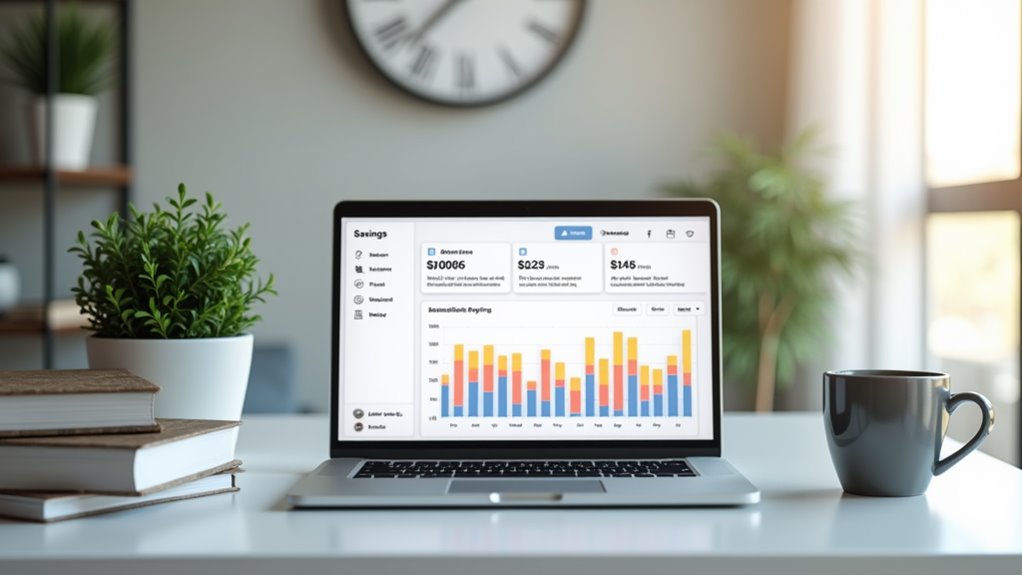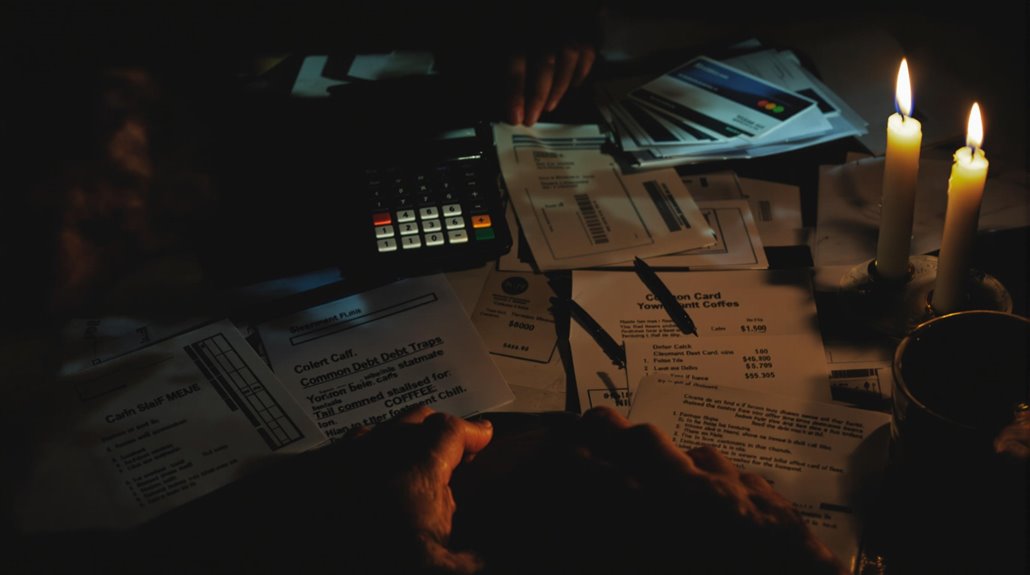
If you hate budgeting, try the 50/30/20 rule. Allocate 50% of your income to necessities, 30% to fun, and 20% to savings and debt. This simple method makes money management easier without strict number-crunching. Automate your savings and payments to reduce manual effort and guarantee bills are always covered. Also, track your spending casually to spot patterns and adjust as needed. Stick around, and you'll discover more tips to manage your finances effortlessly.
Key Takeaways
- Utilize the 50/30/20 rule to effortlessly allocate income towards essentials, discretionary spending, and savings without detailed budgeting.
- Automate savings and bill payments to reduce the effort needed for money management and ensure timely financial obligations are met.
- Track expenses informally by keeping a simple log to identify spending patterns and prioritize financial decisions based on your values.
- Embrace flexibility by adjusting spending categories as needed, especially in high-cost areas or fluctuating income situations.
- Focus on mindful spending by reviewing your financial habits regularly, promoting better choices without the constraints of a formal budget.
Embrace the 50/30/20 Rule for Simple Spending

What it Looks like: The 50/30/20 rule is a straightforward approach to managing your money without the need for a detailed budget. Under this framework, you allocate 50% of your income to essential needs, such as housing, groceries, and utilities. The next 30% goes towards discretionary spending, which includes entertainment, dining out, and personal hobbies. Finally, the remaining 20% is reserved for savings and debt repayment. By categorizing your spending in this way, you can easily track your financial habits without the arduous task of itemizing every expense, allowing for greater flexibility and less stress in your financial management.
Why It's Smart: The simplicity of the 50/30/20 rule makes it appealing for individuals who may find traditional budgeting overwhelming or time-consuming. It creates a clear framework that helps you prioritize your financial goals while still allowing for enjoyment in your lifestyle. By ensuring that half of your income covers essential expenses, you reduce the risk of falling into financial distress. The designated 30% for discretionary spending provides the freedom to indulge in personal interests and activities, which can lead to a more satisfying life. Additionally, the 20% savings cushion can help you build an emergency fund, contribute to retirement accounts, or pay down debt, leading to long-term financial security.
Things to Be Aware of: While the 50/30/20 rule is a beneficial guideline, it may not suit everyone's financial situation. Some people may find that their essential expenses exceed 50% of their income, especially in high-cost living areas. In such cases, adjustments may be necessary, such as reallocating funds from discretionary spending or seeking ways to reduce essential costs. Moreover, the rule assumes a steady income, which might not apply to freelancers or those with variable earnings. It's important to remain flexible and adjust your percentages as your financial circumstances change, ensuring that your spending aligns with your personal goals and priorities.
Automate Your Savings and Payments

What it Looks like: Automating your savings and payments involves setting up systems that allow money to flow from your checking account to savings accounts or to pay bills without requiring manual intervention. This can be done through your bank's online services, where you can establish scheduled transfers to a savings account right after your paycheck is deposited. Similarly, you can set up automatic payments for recurring bills like utilities, rent, and subscriptions, guaranteeing that these crucial expenses are covered without you having to remember to make the payments each month. This creates a smooth, effortless financial management system that operates in the background.
Why It's Smart: Automating your finances helps eliminate the temptation to spend money that should be saved or used to pay bills. By transferring a portion of your income directly to savings as soon as you receive it, you prioritize saving and reduce the risk of overspending. This method also minimizes the likelihood of late payment fees and penalties, as your bills are taken care of automatically. Additionally, automating your finances can lead to increased savings over time, as you may not even notice the money being set aside, allowing your savings to grow without the effort of constant manual tracking.
Things to Be Aware of: While automation can simplify financial management, it is important to monitor your accounts regularly to avoid overdraft fees or missed payments due to changes in your income or bills. You should also verify that you have adequate funds in your checking account to cover automated withdrawals. Moreover, be cautious with automatic payments for subscription services; it's easy to forget about them, leading to unnecessary expenses. Finally, review your automated savings periodically to confirm that your savings goals align with your financial situation and adjust the amounts as necessary.
Track Your Expenses Without a Formal Budget
What it Looks like: Tracking your expenses without a formal budget can take various forms, primarily centered around awareness and mindful observation of your spending habits. Instead of allocating specific amounts to different categories, you might keep a simple log of your daily expenditures. This could be done through an app, a spreadsheet, or even a notebook where you jot down every purchase. Over time, you'll start to see patterns emerge—identifying where most of your money goes, whether it's dining out, groceries, or entertainment. This process allows you to maintain a clear picture of your financial landscape without the rigidity of a structured budget.
Why It's Smart: Managing money without a formal budget can lead to greater financial flexibility and reduce the stress often associated with strict budgeting. By simply tracking your expenses, you can prioritize your spending based on your values and goals, rather than adhering to preset limits. This method encourages a more intuitive approach to finance, allowing you to make informed decisions on the fly. Additionally, as you become more aware of your spending habits, you may find opportunities to cut back on unnecessary expenses, ultimately leading to long-term savings and financial health without feeling constrained.
Things to Be Aware of: While tracking expenses can be an effective way to manage money, it's essential to remain disciplined and consistent to truly benefit from this strategy. Without a formal budget, there's a risk of overspending in certain areas if you don't regularly review your expenses. It's also important to distinguish between needs and wants, as the absence of strict guidelines can sometimes lead to impulsive purchases. Finally, setting aside time for periodic reviews of your spending log can help guarantee you stay on track and make any necessary adjustments, preventing financial pitfalls and promoting a balanced approach to your finances.
RELATED POSTS
View all


